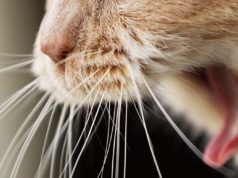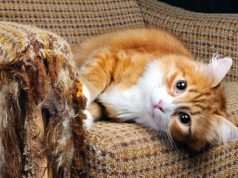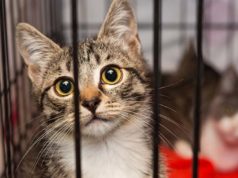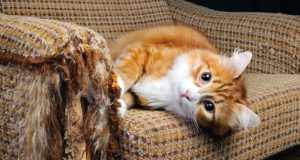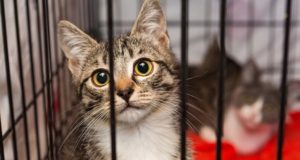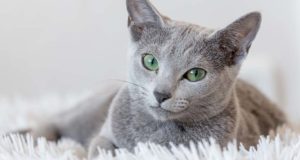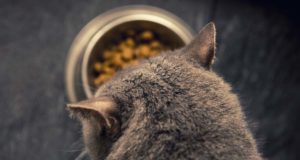If you are a cat owner, then you will understand that as your cat ages, you may expect more health complications. Sadly, they suffer complications of old age, just as we do. Liver disease in cats is one of those serious health complications pet owners must quickly pay attention.
This common condition for aged cats, is hepatic lipidosis, also known as Fatty Liver disease in cats. In layman’s terms, it means that fatty deposits are gathering around the liver. If left untreated it can be fatal. Early intervention can result in a complete recovery. Though not all liver conditions are curable.
“The provision of adequate nutrition, especially protein, is essential for the treatment of cats with feline hepatic lipidosis. These cats are often anorexic which can mean possible tube feeding,” says Dr. Jonathon Lidbury, prof at Texas A&M College of Veterinary Medicine & Biomedical Sciences (source)
While many senior cat food brands are already designed well for certain conditions found in old cats, knowing the exact ways how to feed a feline with this condition is vital. This is what you need to know about liver disease in cats, how to prevent and treat it, and especially how to feed a cat with liver disease.
ALSO READ: How Much to Feed a Cat and How Often Should You Feed Your Cat
How to Feed a Cat with Liver Disease
First, here are a few other liver conditions that cats can suffer:
- Protein deposits that can cause rupture and bleeding of the liver.
- Neutrophilic cholangitis. A bacteria that causes liver inflammation. Prognosis can be good, but further complications can also occur.
- Toxic liver damage. Cats lack the necessary pathways for processing toxins, which makes them more susceptible to liver damage.
- Lymphocytic cholangitis. Could be due to immune system problems. Causes swelling of the liver and fluid in the stomach.
- Hepatic Peliosis. Blood sacs build up in the liver, and can then burst and flood the stomach with fluids.
Did you know…
 1. The liver is one of the most important organs in the body. It works hard to metabolize proteins, fats carbohydrates and aid digestion. It helps to detoxify the body by removing waste. Cats are obligate carnivorous, and eat little vegetation. As a result of this, they do not have the necessary pathways to deal with toxins. This makes them susceptible to liver damage
1. The liver is one of the most important organs in the body. It works hard to metabolize proteins, fats carbohydrates and aid digestion. It helps to detoxify the body by removing waste. Cats are obligate carnivorous, and eat little vegetation. As a result of this, they do not have the necessary pathways to deal with toxins. This makes them susceptible to liver damage
2. The liver is actually a regenerative organ, which means to some extent it can repair itself, if there is no irreparable damage.
3. Even if part of the liver is damaged by infection, or cancer, the rest of the liver works extra hard to make up for the underperforming section. This is why liver damage can go undetected for such a long time.
This shows how devastating liver disease diagnosis is for your cat. As with any chronic or acute disease, the earlier you catch it, the better chance of recovery.
Liver disease in cats
Look for a combination of the following signs:
- One of the first stages of liver disease, is the loss of appetite.
- What your cat does manage to eat, it may vomit up, or suffer excessive diarrhea.
- This leads quickly to weight loss and muscle waste
- Excessive thirst, if your cat is drinking more than usual, it could indicate liver disease.
- Jaundice, yellowing of gums, and even the whites of the eyes.
- Excessive drooling, caused by your cat feeling nauseous.
- While all these symptoms take their toil on the cat’s body, it will be lethargic and sleep more than usual.
 If your cat is displaying any number of these signs, then it’s time to visit your local veterinary surgery for blood tests. If the results show liver disease, you will be given advice on a change of diet that will help to prolong your cat’s life.
If your cat is displaying any number of these signs, then it’s time to visit your local veterinary surgery for blood tests. If the results show liver disease, you will be given advice on a change of diet that will help to prolong your cat’s life.
Your cat is going to struggle with the wrong diet, so it is important to heed the warning signs. You will need a correct disease diagnosis to assess the quality of dietary needs, and stall the damage progression. For instance:
- Liver disease that is producing water retention, requires a low sodium diet.
- Protein intake will be dependent on what type of liver disease your cat has, and at what stage the disease is at. For instance, cats with hepatic lipidosis cannot process protein and the amino acids, so a low protein diet will be necessary. Your vet will advise you on this.
A good balanced diet for a cat with liver disease can greatly increase its life span.
Feeding a cat with liver disease
Just like feeding a cat with sensitive stomach, there are important rules to follow when changing and adjusting your feline’s diet to a new protocol. Here are some essential cat liver disease feeding tips:
- Any changes you make should be gradual, to give your cat time to adjust to the new diet.
- A food that is high in good quality protein, means your cat’s liver will not have to work as hard to process it. Though be careful, certain liver diseases and their associated illnesses, such as hepatic encephalopathy, require a low protein diet. your vet is the best one to advise you on this.
- A reduced sodium diet, will help to reduce fluid retention
- Foods that contain high quality carbs, which are easily digestible, such as cooked, rice, wheat and corn. Whilst carbs amount for only a small part of a cats diet in the wild, it will help with energy levels if they are on a low protein diet.
- Food with added antioxidants, such as Vitamin E and Vitamin C, can help with reducing damage to cell tissue in the body. This damage is a result of the high levels of toxins such a disease produces.
- Wean off all dry foods, as your cat may have difficulty chewing and swallowing this. Wet cat foods are much easier on the digestive system. If your cat has no appetite, then try spoon feeding.
- If your cat is struggling to eat, then liquidize, or mush the food to a pulp. If you do have to spoon feed, consider a syringe, and liquify the food, or water it down.
- Replacing meat based proteins with dairy, can help with hepatic encephalopathy. This is a brain condition caused by excessive ammonia, due to the liver disease. Normally, a cat should not eat much in the way of dairy products. This is one of the few times when it could benefit from dairy foods, such as scrambled eggs or cottage cheese.
If your cat has become anorexic, then hepatic lipidosis is probably the reason why your cat is not feeding. In extreme cases, the vet will fit a feeding tube into the stomach. This will be the only way to ensure the poorly cat receives some nutrition.
The problem is that not eating only serves to exasperate the liver condition, until it becomes fatal. The vet may also give appetite stimulants and anti vomiting tablets at the same time.
Veterinarians also warn about protein consumption, and how in some cases, low protein cat food brands may be a better option to restrict the amount of protein consumed:
“Unfortunately, like many diseases, liver disease can progress and become worse. Thus, patients that initially did not require protein restriction may later benefit from restriction.” – UC Davis Veterinary Medicine (source)
While commercial cat food brands are well-designed for specific health conditions in cats, you may also want to consider homemade cat food:
- Cooked rice.
- Cooked chicken or turkey. Blend it together if your cat has troubles chewing.
If you choose home cooking, that is wonderful, but you may need to also provide your cat with supplements. This is because tinned food often already has the supplements added to their meals:
- Vitamin B12 will help your cat’s digestive system absorb better.
- Vitamin E (give water soluble only), will provide a certain amount of protection for the liver, from further damage.
- Vitamin K helps with blood clotting.
- S-adenosylmethionine (SAMe), as well as L-carnitin are recommended supplements, by vets. SAMe helps the liver to heal. L- carnitin protects it from acids produced by the body.
You can prolong the life of a cat diagnosed with liver disease, but do check all details with your vet first. It’s important get it right, and give you pet cat the best care possible.
READ NEXT: 25 Most Common Cat Diseases and How to Prevent Them





